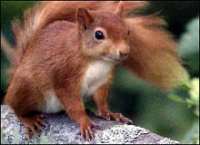


The Wild Flower Page
February 2000

|
|

Mating hedge for squirrels in Jersey The
States of Jersey Government has started to plant more than 16,000 trees
and bushes in a diagonal line linking a colony of red squirrels at St Brelade,
in the south-west of the island, with another at St Martin, in the north-east. The
States of Jersey Government has started to plant more than 16,000 trees
and bushes in a diagonal line linking a colony of red squirrels at St Brelade,
in the south-west of the island, with another at St Martin, in the north-east.
The imaginative scheme is intended to allow native populations to mix and share their genes. The existing groups are at risk of extinction due to their dwindling territories. Red squirrels are not native to Jersey - they were introduced from England and France - but they are much loved locally. The competitive north American grey squirrels have never been introduced but there are now only about 400 red squirrels left. They have suffered from the loss of thousands of trees from Dutch elm disease and the ravages of the great storm of 1987 which destroyed much of the red squirrels' habitat. Remaining woods are too small and fragmented to support colonies of the squirrels. Traditional varieties of trees and hedgerow shrubs have been chosen for the new mating corridor to provide habitats and food supplies. Louise Magris, the state biologist in charge of the project, said that the corridor was the best way to solve the problem: "We hope that the new tree corridor will secure the future of our red squirrels." Pioneering purchase spearheads new coastal visionThe Essex Wildlife Trust is leading a joint venture to purchase Abbotts Hall, a 700 acre arable farm on the Blackwater Estuary near Colchester. The Trust is supported by its national body The Wildlife Trusts and an impressive range of conservation partners.As global warming leads to rising sea levels around Britain, important habitats such as salt marsh and grazing marsh will be squeezed out. The Essex Trust plans to revert more than 200 acres of arable land back to marshes to support wildfowl like Brent geese which overwinter here, wading birds like redshank and lapwing which nest, and birds of prey like the Hen Harrier. It is a visionary project, of national importance, which, if successful, will link together over 25 kilomteres of Essex coast. Over 300 acres of Abbotts Hall will remain as arable land. The Trust plans to farm this in as wildlife-friendly way as possible by restoring hedgerows, copses, ponds, ditches and grass strips to show how farmland wildlife and particularly birds like songthrush and skylark, which are in such desperate decline, can flourish alongside profitable arable farming. This will be one of the first of a network of arable farms which The Wildlife Trusts aim to establish in the UK to influence grant aid for other farmers who want to farm in a way which is more environment friendly than the current subsidy systems dictate. Simon Lyster, Director General of the Wildlife Trusts said "Abbotts Hall will be a national flagship for The Wildlife Trusts as the largest coastal management project we have ever undertaken and it will be the largest area of arable land a Wildlife Trust manages anywhere in the UK". John Hall, Director of Essex Wildlife Trust said "This is a tremendous opportunity to show habitat restoration on the coast and to show that both farming and wildlife can be supported, but we will need a lot of support from our members, the public and the local community to ensure the potential for wildlife and people at Abbotts Hall is fully realised." The Essex Wildlife Trust has been able to consider this ambitious project because of the legacy left by the late Joan Elliot and crucially further support is required from public donations to raise the last £60,000 towards the purchase and £170,000 for conservation works. Coastal defences to protect 2000 acres of NorfolkA £1.25 million project, the first in a programme to protect coastal wildlife reserves from rising sea levels and more frequent and violent storms, will be constructed at Burnham Overy and Wells on the north Norfolk coast.The new defences will mean that occupiers of 52 homes can sleep at night - and so can 10,000 wildfowl and breeding birds, including avocet and brent, pink-footed and white-fronted geese. The 2,175-acre area will benefit from a £1 million central government grant, the first under the revised system which now takes account of the conservation value of endangered areas, under EU rules. The announcement is seen as a precursor to other schemes which will be needed to protect wildlife reserves, including the Cley-Salthouse area. John Sharpe, the RSPB's conservation officer, said yesterday: "This vital decision sets a precedent that will ensure funding is found for schemes such as the urgently needed Cley-Salthouse sea defences." 100 Londoners need our helpThe London Biodiversity Action Plan was launched recently, with a list of one hundred animals and plants which will need special protection to thrive in the future.The London Biodiversity Partnership says that the 100 species signify the health and wealth of wildlife in the London region. The list includes not only well known favourites such as the hedgehog, skylark, and water vole but also black redstart, pipistrelle bat, large garden bumblebee, small blue butterfly, and hornet robberfly. "Despite huge urban development, London is one of the best cities in the world for wildlife," said Lesley Hilton, chairman of the London Ecology Committee. "However, many species are declining. The London biodiversity action plan will help to manage and protect wildlife so future generations can continue to enjoy nature in the city." London is the first British city to have a mayor with a statutory responsibility to draw up a biodiversity action plan. The report is intended to assist the new mayor in meeting his environmental responsibilities under the Greater London Authority Act when he or she takes office. The project also imposes a duty on companies, councils and organisations to take into account the 100 species and their habitats when building roads and railway lines to redevelopment sites. Like all great cities, London has a network of lakes, meadows, gardens, derelict land, rail embankments and overgrown cemeteries, which are surprisingly rich in wildlife, with more than 2,100 flowering plants and ferns growing wild. The scarce emerald damselfly can be seen at Rainham marshes and the rare hornet robberfly is found on grazed land along the east Thames corridor. Other little-known species found in the capital include the German hairy snail, which grazes on Thames-side rubbish, and London rocket, a plant that was common around the time of the Great Fire and can still, it is believed, be found near the Tower of London, although it was last recorded in 1974. London Biodiversity Action Plan Slimbridge restoredA £6 million scheme to renew facilities at one of the world's best-known wild bird centres has turned it back into one of the most popular tourist attractions in the south-west.The Millennium Commission grant, covering half the cost of the project, enabled the building scheme to be launched. It includes a viewing tower giving views across the reserve to the river Severn and beyond to Wales and the Forest of Dean. It has proved so popular that visitors have to book a place on a tour of the tower to ensure they get to the top. The building uses sustainably sourced timbers, recycled metals and other materials chosen for their energy efficiency and low impact on the environment. The complex now boasts a spectacular visitor centre, reached by a boardwalk over a lake, a much bigger shop, wildlife art gallery and the Water's Edge restaurant, where local produce is on the menu. A reedbed filtering scheme processes and cleans all water-borne visitor waste and even the electricity is bought from a renewable source. Trust spokeswoman Claire Warner said: "None of us could believe how smoothly it all went. We have two full-time teachers and schoolchildren can come to study as part of their curriculum. "But we still have a link with the earlier days of the trust as the original cottage which Sir Peter lived in when he came here in 1946 is still in the grounds and we hope to turn it into a museum ... The response to the project has been overwhelming. Some regular visitors cannot believe the transformation. We are currently working on an official opening in February but we are open now for anyone to come and see what a difference the project has made." Saving CannockStaffordshire County Council has announced that it will launch a five-year plan to restore Cannock Chase to its former glory in Spring.The programme, 'Saving Cannock Chase', will cost £725,000, of which £522,000 will come from the National Lottery, the remainder being funded by a partnership of the county council, English Nature and the Countryside Agency. The project has already begun with cutting back the bracken which invaded the Chase during the 20th century and ruined most of its native heathland. Spraying with an approved herbicide has been trialed in the Oldacre Valley and Brindley Heath areas over the past few months and the results of the programme are expected in the Spring, when the project will be launched officially. Sue Sheppard, project officer for Saving Cannock Chase, said that the country park was Staffordshire's most significant area of heathland and that as such should be preserved. However, she said activities such as farming and forestry as well as the invading bracken were all threats to the traditional landscape. "The heathland vegetation on the Chase has been managed since 1974, but there has never been the resources to fully reverse the decline, which is what Saving Cannock Chase aims to do," she said. Otters at home in Stafford town centreFollowing recent evidence of otters living in the centres of Gateshead and Edinburgh (Conserv@tion December 1999), the Staffordshire Wildlife Trust has recorded evidence of otters in Stafford over the past 23 months. The general improvement in river water quality has led to otters returning to town centre waters where they have not been seen for decades."Otters are enjoying a recovery at the moment and expanding their range from traditional strongholds in Wales and Shropshire," says Trust Otters & Rivers Project Officer, Nick Mott. "Stafford is extremely significant in terms of otter activity and represents a major focal point as they explore out from the west. The Sow and Penk rivers that drain most of western Staffordshire actually meet up in the town of Stafford before going on to join the River Trent at Shugborough." "What's exciting is that otters have become resident in the area, using Doxey Marshes to the west and Baswich Meadows to the east as major feeding areas for their night time forays," Nick added. The Otters & Rivers Project is working in partnership with the Environment Agency and Severn Trent Water to restore stretches of suitable habitat for otters with the aim of providing secure resting and breeding sites along the Sow and Penk river corridors. There is also an opportunity for Stafford Borough Council and its 'Riverscape' project to undertake enhancements for otters, fish species and water voles. Free trees for BurnleyThe 'Forest of Burnley' project is offering trees free to landowners.The deal is available to anyone able to help the project by providing at least a quarter-acre of land and manage the trees for ten years. "It is an exceptionally good offer and we hope people will join the scheme," said Burnley council's project officer Simon Goff. "We will also organise a Tree Spree later this year to enable householders to plant trees in their gardens." The initiative is intended to get the Forest back on target in its aim to plant one million trees, which has met setbacks recently. English Nature has objected to the foresting of 150 acres of North West Water land at Worsthorne. The land concerned is part of the South Pennines Special Protected Area, which is an important bird habitat which EN feels would be damaged by planting. The original £250,000 scheme is likely to be much curtailed by any negotiated solution. At a 460 acre site at Dunnockshaw the Forest project has spent £20,000 drawing up a major study on the impact the scheme would have on wildlife and the environment, including widespread consultation with bodies such as the Royal Society for the Protection of Birds and the Forestry Commission. It hopes that 250 acres of the 460 acre site may be planted but this depends on Woodland Grant support and a decision is expected soon. The Forest scheme, which has already had £1.7million grant support from the Lottery Millennium Fund, has so far planted 275 acres of land - a quarter of a million trees. New SSSI for ClevelandThe latest Site of Special Scientific Interest to be named in Cleveland is one of only two to be listed for its invertebrate importance.Lovell Hill Pools is the result of mining subsidence. The combination of shallow ponds, swamp vegetation, willow carr and scrub is a rich habitat because it provides sheltered breeding and feeding sites. Dragonflies and damselflies, including the rare Variable Damselfly, are found here. "Thirteen species of dragonfly may not be unusual for the New Forest but very uncommon if you live in the North-East," says Ken Smith, a consultant with the Industry and Nature Conservation Association, a partnership of industrialists and conservationists on Teesside. "Even so, there are 13 species to be found at the ponds. Several are migrants, but nine species breed there." "I think there may be one other SSSI in the country designated for the protection of invertebrates. You usually get SSSI's designated for areas which have birds and flowers so this is quite an achievement." Not all local residents appreciate the area for its invertebrates. Rita Skillcorn, a resident of the nearby village of Dunsdale, near Guisborough, said: "It is a beautiful area and from your window looks the perfect place to have a picnic, but there are always too many flies.'' |

Northern Ireland birdwatchers can help new web siteA birdwatchers' web site, launched in late 1999, is asking for assistance with the best places to watch birds in Northern Ireland.www.birding.uk.com is run by Stella Baylis and Phil Rennett. The site provides information on the best places to watch birds, all over Britain. But Stella and Phil can only run the site in their spare time and are asking for information from other birders in order to complete the site in the shortest possible time. "We want to hear from birdwatchers who can provide us with details of the best birding locations in their area," says Phil Rennett. "We're particularly interested in hearing from birders in Northern Ireland, a birding region which is still developing," he added. Anybody interested in helping with the site should check out some of the other location reviews and then complete the online location review form with as many details as possible of the major sites in their own area. Plastic wrapper will protect fenThe Pollardstown Fen nature reserve is to be protected by wrapping the proposed Kildare bypass in plastic, to prevent dewatering of the sensitive fen.The £68 million project is dependent on EU funding to provide traffic with an alternative to the notorious Kildare bottleneck. Last year the hydrology of the fen became an issue, delaying implementation of the engineering (Conserv@tion September 1999). The fen at Pollardstown is a rich environment for, among other things, the rare snail Vertigo angustior, and construction will involve draining millions of gallons daily from the water-rich Curragh Aquifer to facilitate the bypass through it and drying-out the fen. Now 1.5km of the road will be lined with a plastic membrane at an extra cost of at least £5m to prevent any serious de-watering of the Fen and flooding of the motorway. It remains to be seen if the EU will accept the revised plan - the National Roads Authority has been instructed to recommence work but Duchas, the state heritage service, has only reluctantly gone along with the futuristic method. European study confirms Irish algal pollutionEvidence has been building, over the last few years, for an increasing problem with algal build-up in many of Ireland's best known loughs. Now a major study has confirmed this.Where modern farming has led to nitrogen runoff into water courses the increase in nutrients in the loughs produces an algal 'bloom', which can lead to poisonous scums. At least one dog was killed last summer by drinking such a fatal bloom. The Environmental Protection Agency commissioned a European Regional Development Fund study during 1996-98 period. It was coordinated by Dr Andrew Petersen of Cork Institute of Technology. More is now known about the key area of concern, harmful toxins associated with bloom formation, even if the exact environmental conditions for their production still escape scientists. The most disturbing conclusion is perhaps the ease with which cyanobacteria "achieve plankton dominance" in what are essentially lowland limestone lakes, which account for some of Ireland's most important lakes. "This tendency is endemic," it concludes, "and readily manifested by quite mild levels of eutrophication." In short, with Irish lakes generally there is a strong tendency to bloom formation. |

Scots alders are dying, not from the phytophthora fungus
outbreak which is slowly moving up England and Wales (Conserv@tion June
1999), but from a novel form of 'dieback'.
|

The rats on Ramsey Island, the tiny nature reserve off the
west coast of Pembrokeshire, have been thriving - so much so that the RSPB
has decided that their time has come. RSPB volunteers have laid out more
than 1,200 poison stations around the island in an eradicationprogramme.
The poison stations, designed to put no other creature at risk, will be
checked every day for at least three months.
|
Top

 Scots
alders falling under mystery disease
Scots
alders falling under mystery disease Cairngorms
SPA extension
Cairngorms
SPA extension